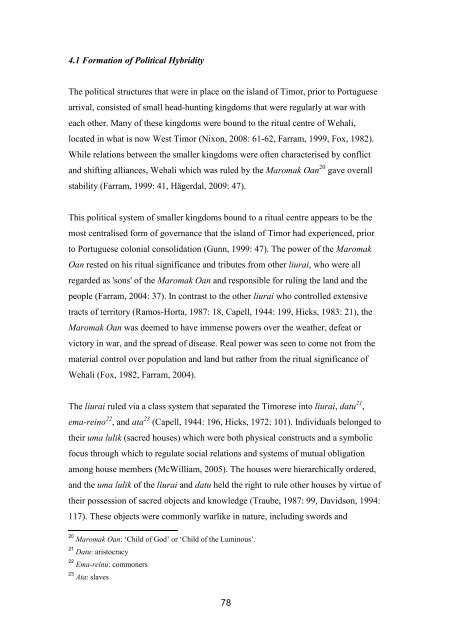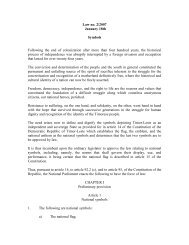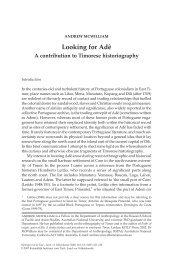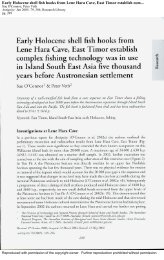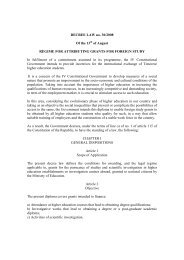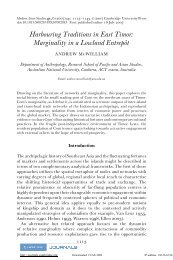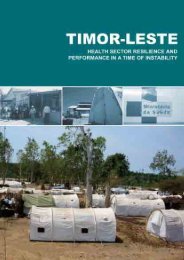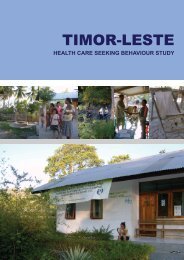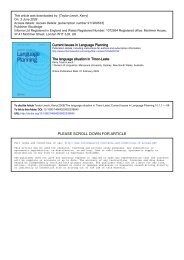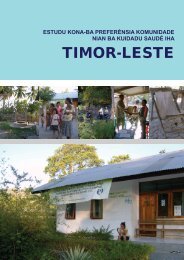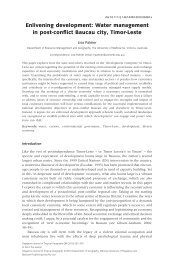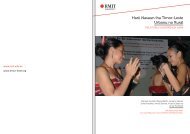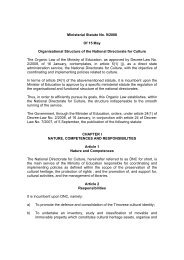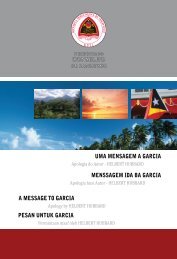- Page 1 and 2:
Local Governance in Timor-Leste:The
- Page 3 and 4:
COPYRIGHT STATEMENT‘I hereby gran
- Page 5 and 6:
are some important points of tensio
- Page 7 and 8:
the Canossian sisters in Ainaro—M
- Page 9 and 10:
2.6 The Issues of Cross-Cultural Re
- Page 11 and 12:
LIST OF FIGURESFigure One: The Deve
- Page 13 and 14:
Tara banduUma kainUma lulikXefe Ald
- Page 15 and 16:
within, I had failed to recognise t
- Page 17 and 18:
anthropology of development (Shephe
- Page 19 and 20:
prefer the term 'local' to recognis
- Page 21 and 22:
evolve around ideas of traditional
- Page 23 and 24:
institution that is considered to b
- Page 25 and 26:
the case given the emphasis on cond
- Page 27 and 28:
Within these increasingly murky pol
- Page 29 and 30:
1.3 Case Study SitesVenilaleVenilal
- Page 31 and 32:
The reasons for choosing Venilale a
- Page 33 and 34:
and influences can have on the loca
- Page 35 and 36:
played out since decolonisation. Th
- Page 37 and 38:
geographically 'outwards' from uma
- Page 39 and 40: CHAPTER TWO: METHODOLOGICAL FRAMEWO
- Page 41 and 42: 2.1 FieldworkFieldwork was conducte
- Page 43 and 44: marked differences in people's idea
- Page 45 and 46: interactions between modern and tra
- Page 47 and 48: then asking for advice on who else
- Page 49 and 50: answer specific questions about how
- Page 51 and 52: Every conversation and every experi
- Page 53 and 54: discussions. This took a little tim
- Page 55 and 56: crucial to the research question—
- Page 57 and 58: CHAPTER THREE: CONCEPTUALISING POST
- Page 59 and 60: epresentation through democratisati
- Page 61 and 62: of coordination between these diffe
- Page 63 and 64: equally problematic, as this succes
- Page 65 and 66: government, and Huntington noted th
- Page 67 and 68: Westernise. Equally, the specificit
- Page 69 and 70: which individuals both shape and ar
- Page 71 and 72: expanded this understanding to incl
- Page 73 and 74: within a society. As Remmer puts it
- Page 75 and 76: is to distribute power to some and
- Page 77 and 78: To explain this point, he makes the
- Page 79 and 80: provided by public policy" (Fukuyam
- Page 81 and 82: Gramsci's account of hegemonic powe
- Page 83 and 84: From this perspective, Gramsci's id
- Page 85 and 86: outcomes. Rather, it structures soc
- Page 87 and 88: 'shadow side' of the everyday polit
- Page 89: The centrality of these kin-based g
- Page 93 and 94: While the rule of the liurai was in
- Page 95 and 96: to be rejoined. But as local politi
- Page 97 and 98: in Europe, this was seen somewhat d
- Page 99 and 100: did not make life any easier for th
- Page 101 and 102: governor, but slowly seats were inc
- Page 103 and 104: The movement towards decolonisation
- Page 105 and 106: As the politics reached gradually b
- Page 107 and 108: appointed traditionally (Ospina and
- Page 109 and 110: esistance to Indonesian rule (Gunn
- Page 111 and 112: outrage across the world. Following
- Page 113 and 114: f) To assist in the establishment o
- Page 115 and 116: egan to return from their hiding pl
- Page 117 and 118: for a Constituent Assembly (CA) and
- Page 119 and 120: these other factors reveal a more c
- Page 121 and 122: SECTION TWO: EXAMINING LOCAL GOVERN
- Page 123 and 124: hold spiritual and ritual responsib
- Page 125 and 126: Important exchange relationships th
- Page 127 and 128: spiritual significance of the ances
- Page 129 and 130: ight to freedom, for anyone to occu
- Page 131 and 132: The centrality of the liurai house
- Page 133 and 134: As discussed previously, one of the
- Page 135 and 136: order to meet their communal requir
- Page 137 and 138: community, or communal expectations
- Page 139 and 140: within the suku and to lead the kon
- Page 141 and 142:
epresentative. These political mech
- Page 143 and 144:
structural issue: while the old ins
- Page 145 and 146:
democratisation has been seen to er
- Page 147 and 148:
Party politics has been one such po
- Page 149 and 150:
on the leaders' position within the
- Page 151 and 152:
Within this hybrid political enviro
- Page 153 and 154:
in the community. While there is a
- Page 155 and 156:
authority figures in the aldeia, su
- Page 157 and 158:
As fieldwork progressed, it became
- Page 159 and 160:
kain), it is taken to the xefe and/
- Page 161 and 162:
process, they have the right to go
- Page 163 and 164:
(March, 2008). In the absence of le
- Page 165 and 166:
explains, he will not engage with a
- Page 167 and 168:
this distinction. When I asked abou
- Page 169 and 170:
insufficient attention being paid t
- Page 171 and 172:
of barlake that lay in the alliance
- Page 173 and 174:
functional, leaving them especially
- Page 175 and 176:
affiliation with political parties.
- Page 177 and 178:
xefe suku explained that the cost o
- Page 179 and 180:
that there is a combination of soci
- Page 181 and 182:
SECTION THREE: SHAPING LOCAL GOVERN
- Page 183 and 184:
automatically become part of the lo
- Page 185 and 186:
ecent Shadow Report to CEDAW, which
- Page 187 and 188:
Governance must be for something, a
- Page 189 and 190:
power within Timorese communities.
- Page 191 and 192:
Such structural constraints, howeve
- Page 193 and 194:
Across every suku in Venilale and A
- Page 195 and 196:
was built for their most remote ald
- Page 197 and 198:
While community members may attempt
- Page 199 and 200:
networks that use such animistic ri
- Page 201 and 202:
strongman, who operated in Venilale
- Page 203 and 204:
the community are captured or diver
- Page 205 and 206:
strongman specifically uses institu
- Page 207 and 208:
CHAPTER EIGHT: BRINGING IT BACK TO
- Page 209 and 210:
communities have created various fo
- Page 211 and 212:
However, while incoming resources c
- Page 213 and 214:
of fundamental importance in consid
- Page 215 and 216:
APPENDIX A: LIST OF INTERVIEWEESVEN
- Page 217 and 218:
APPENDIX B: MAP OF TIMOR-LESTESourc
- Page 219 and 220:
APPENDIX D: POLITICAL MAP OF SUBDIS
- Page 221 and 222:
BINNS, T. (2006) 'Doing Fieldwork i
- Page 223 and 224:
CHESTERMAN, S. (2002) 'East Timor i
- Page 225 and 226:
DEGNBOL-MARTINUSSEN, J. (2002) 'Dev
- Page 227 and 228:
Lincoln, Y. (Eds.) The Landscape of
- Page 229 and 230:
GRENFELL, L. (2006) 'Legal Pluralis
- Page 231 and 232:
HOWARTH, D. (2000) Discourse, Bucki
- Page 233 and 234:
LANDMAN, T. & HAUSERMANN, J. (2003)
- Page 235 and 236:
MERRY, S. E. (1988) 'Legal Pluralis
- Page 237 and 238:
OSPINA, S. & HOHE, T. (2001) Tradit
- Page 239 and 240:
RUDOLPH, L. I. (1965) 'The Modernit
- Page 241 and 242:
THAKUR, R. & VAN LANGENHOVE, L. (20
- Page 243:
WORK, R. (2002) 'Overview of Decent


